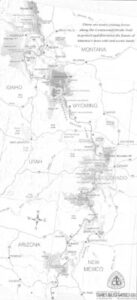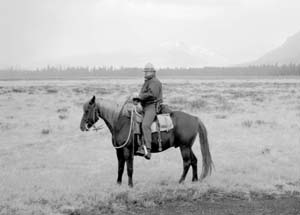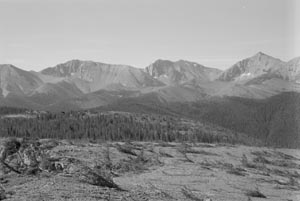They are nature’s own Greek chorus — plumed performers, dancing and chanting in a Dionysian frenzy, celebrating fertility, foreshadowing tragedy. Their own.
The sage grouse has been dubbed the spotted owl of the plains. The sage grouse’s future depends on the willingness of Wyoming oil, gas and livestock industries, which owns 90% of the land, to reform their ways. Environmentalist’s have petitioned to have the grouse listed under the endangered species act. A male sage grouse engages in a mating dance to establish territory and find mates on a “lek” or mating ground in early morning sunlight in Wyoming.
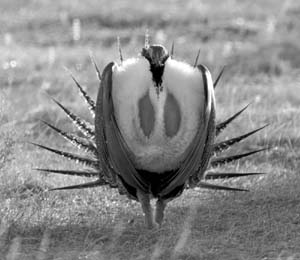
It is dawn in the Jack Morrow Hills, a patch of pimples on the edge of Wyoming’s Great Divide Basin, a mesmerizingly barren expanse of sage that one 19th century traveler said only “a mad poet” could love. During their mating dance, the strutting sage grouse flare their tails like peacocks in brown camouflage and croon their own love poetry. They sound strangely like burbling water coolers, only louder.
The sage grouse is among the West’s oldest inhabitants. Its theatrical mating rituals have heralded the arrival of spring on the western plains for thousands of years. But its numbers are dwindling steadily, and in many places it is gone.
Federal wildlife officials currently are evaluating petitions from conservation groups to place the sage grouse on the endangered species list. If protection were granted, restrictions on land use would follow.
For the state’s powerful mining and petroleum industries – along with ranchers, farmers and sportsmen – a federal listing could turn the grouse into the prairie equivalent of the spotted owl, raising the specter of years of social strife and economic pain as has occurred in the Pacific Northwest.
An icon of a more primitive America, the sage grouse is a casualty of the forces that have modernized it: irrigated agriculture, the oil and gas industry, motorized recreation and suburban expansion. Along with wildlife experts, residents of rural Wyoming rue the bird’s decline. They fear the degradation of open space that sustains human as well as animal life.
But Wyomingites face a dilemma. The forces that drive their economy are the same that could run roughshod over the sage grouse and turn the lonesome prairie into an industrialized plain.
“We all need petroleum products, but the question we are beginning to ask ourselves is at what price,” said Rod Rozier, a former oil field engineer who now ranches in sage grouse country northwest of the Great Divide Basin.
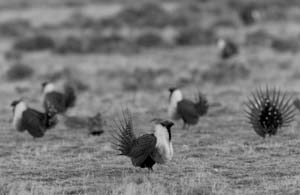
Nowhere is grouse more numerous than in Wyoming. Nowhere are habitat conditions more favorable. But few states are more dependent on the energy industry, and today that industry is abuzz with bright new natural gas prospects, many of them in the heart of the state’s best grouse habitat.
While wildlife can coexist with oil and gas wells, “it’s all a matter of scale, how fast and how much you develop,” said Doug McWhirter, a wildlife expert with the Wyoming Department of Game and Fish.
Trouble comes, McWhirter said, when an energy boom overwhelms a landscape with construction, roads, people, traffic and noise. Such a boom is in the offing, and it won’t be easy to apply the brakes. A state without an income tax, Wyoming depends on taxes and royalties from oil and gas for nearly half of its general fund. Some counties that get up to 80% of their revenues from energy taxes couldn’t function without the industry, at least not without significantly higher taxes on local residents.
“If there is anything that Wyomingites love more than their wildlife, it’s low taxes,” said Andy Tenney, a Wyoming resident who works for the federal Bureau of Land Management.
Beyond the colorful bird, the future of one of America’s most extraordinary empty places is at stake. For thousands of square miles, Wyoming’s Great Divide Basin and its environs spread out across sage covered hills, sand dunes, buttes and canyons. If any place south of the Alaskan tundra qualifies as America’s Serengeti Plain, this is it. The desolate country, near the center of the state, is home to wild mustangs, mule deer, elk and 50,000 pronghorn, the largest herd of its kind in the world.
Pioneers dubbed the area the Great American Desert. Hundreds of thousands of emigrants and gold seekers crossed it in covered wagons. The ruts of the Oregon Trail are plainly visible, as are the remnants of stage stops, Pony Express stations and grave markers.
Since the 1890s, politicians and naturalists have made repeated efforts at restricting industrial activity from the region by proposing a game refuge or the state’s third national park after Yellowstone and Grand Teton. But mineral interests always have prevailed. Gold, jade and uranium have been found in abundance. So has natural gas.
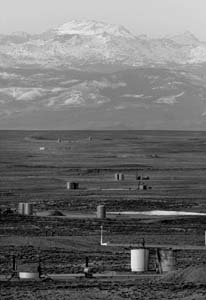
The primacy of energy interests recently influenced the direction of the nation’s longest hiking trail. Pending development of gas leases on the west side of the basin led federal officials to reroute the 3,200 mile-long Continental Divide National Trail away from some of the most scenic country in the Divide Basin and onto a dirt road.
Although most of the basin is public domain, federal land managers have traditionally bowed to the interests of commercial lessees when it has come to balancing public access and recreation with those of livestock, mining and oil and gas.
The southeast corner of the basin is already blistered with wells, tanks, compressors, roads, pipelines and waste pits. Much more development is planned. The entire region could see another 10,000 wells over the next decade. New technology that has made it easier and cheaper to locate and extract gas from subterranean sands and coal seams could make Wyoming the premier natural gas producing region of the country, according to the U.S. Bureau of Land Management. Wyoming currently ranks fifth in gas production.
One of the most effective techniques for extracting the gas requires the expulsion of millions of gallons of underground water. It is a process that some scientists worry could dry up water sources that livestock and wildlife depend on.
People here always have had a soft spot for the sage grouse. Plains Indians imitated it in their dances. Lewis and Clark were enthralled by it. These days, the bird’s plight is one of several environmental factors prompting a reassessment of the oil and gas industry that prop up the state’s economy.
“We’re just now starting to examine the hidden costs of production,” said rancher Rozier. “We’re just now asking whether it is always worth it.”
About 50% of the grouse’s historic nesting grounds in the western United States and Canada already has been lost to human development. A species that once numbered more than a million now may be down to 160,000 birds scattered across parts of 11 states – including several thousand in far northeastern California – and two Canadian provinces.
The sage grouse belongs to the old, unpeopled West, which Wyoming with its absence of cities, and sparse population prides itself in representing. It is the least populous state and the only one to have fewer residents than a decade ago.
The sage grouse needs the peace and quiet of the untrammeled prairie. Out here, humans’ sympathy for the birds is bound up with their own love of open spaces.
While environmentalists hatch strategies to save the species, cowboys concerned about the proliferation of natural gas wells across the range, have been among the most eloquent defenders of the habitat they share with the birds and a host of other wildlife.
“The opportunity to ride a horse on the top of the mesa at day break,” said Wyoming cattleman Albert Sommers, Jr., “and be surprised by a burrowing owl clattering out of a badger hole is exciting. The opportunity to be part of a family that has enjoyed the wintering mule deer herds is unique. The opportunity to walk through the sagebrush in the summer and watch fat horny toads soaking up the sun makes me smile.”
Sommers was addressing a hearing convened by federal officials who must decide the fate of 200,000 acres of sage grouse habitat that lie atop the most productive natural gas field in the state outside the town of Pinedale.
Energy companies are waiting for permission from the BLM to drill from 300 to 1,000 new wells in the Pinedale area alone. The conditions governing the expanded activity will represent the government’s first attempt to protect sage grouse since the bird was declared a potential candidate for the endangered species list.
The federal government owns much of the land overlying the most promising oil and gas strata in Wyoming. But typically, energy leases, some of which were first issued 50 years ago, grant broad license to drill.
Up to now, the BLM, which manages the land and granted the leases, has said it has little power to lessen the impact of drilling. The agency hasn’t indicated yet whether it plans to take a tougher stand on the anticline and in the most sensitive areas of the Great Divide Basin such as the Jack Morrow Hills. However, it has admitted that fields with eight or more wells per square mile could have serious environmental consequences.
“In some areas, development will lead to significant adverse impacts to water resources, wildlife and wildlife habitat, i.e. big game (antelope and mule deer) and sage grouse,” the BLM concluded in a first draft of its analysis of the anticline project. “No technically or economically feasible level of mitigation can be applied in these areas to minimize the severity of impacts.”
Sage grouse has been in the way of progress for 100 years or more, ever since the Homestead Act of 1862 invited the carving up of the open range. Millions of acres of habitat were transformed as farmers flooded fields and used mechanical beaters and chemicals to destroy sagebrush. Domestic livestock, too, has taken a toll, competing with sage grouse and other wildlife for the native grasses that grow in between clumps of sagebrush. Over time, a combination of fences, roads, power lines and pipelines created new access for poachers as well as for the predators that prey on grouse, including hawks, eagles, foxes and coyotes.
In Wyoming’s wide open spaces, where the grouse numbers hover around 20,000, representatives of the oil and gas industry point out that they have been drilling here for 115 years without causing serious consequences to most of the state’s wildlife.
“We must have been doing something right,” said Rick Robitaille, president of the Petroleum Association of Wyoming.
At first glance, it does seem as though the wildlife has outlasted each new boom. On the Continental Divide Trail, herds of wild horses lope across the tailings piles of abandoned uranium mines. Nearby, antelope browse in the ruins of Jeffrey City, once the capitol of the state’s uranium boom and now virtually deserted.
The wildlife returns, but in smaller numbers, biologists say. One of the main reasons is that continual disturbances to the land have degraded the forage, replacing native grasses with hardier but less nutritious varieties.
Alison Lyon, a biologist hired by the petroleum industry to study the effects of well fields on wildlife, has noted sage grouse declines.
“We are seeing fewer birds and lower nesting rates in places where industrial infrastructure is particularly dense.”
The best strategy to avoid a crisis of spotted owl proportions, say wildlife experts, is to come up with voluntary plans to protect the sage grouse in its remaining strongholds.
“If we get enough conservation practices to remove the most serious threats it could lead to potential avoidance of listing,” said Pat Deibert, a biologist with the U.S. Fish and Wildlife Service in Wyoming, who will play a key role in deciding whether to list the sage grouse.
The Endangered Species Act is perhaps the single most detested piece of federal legislation in this part of the country. The prospect of another listed species could prompt the kind of voluntary conservation efforts Deibert hopes for. Still, it won’t be easy.
Rancher Paul Hagenstein, who has relied on gas leases on his property to tide him over lean years, summed up the dilemma facing many people in Wyoming.
“No amount of royalties will ever give me the enjoyment of sitting on a ditch bank in the morning and watching the deer, the ducks and the grouse. On the other hand, I wouldn’t be sitting here at all if it weren’t for those royalties.”
©2001 Frank Clifford
Frank Clifford, an environmental writer for the Los Angeles Times, is researching the Continental Divide Trail.

